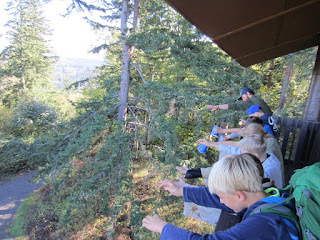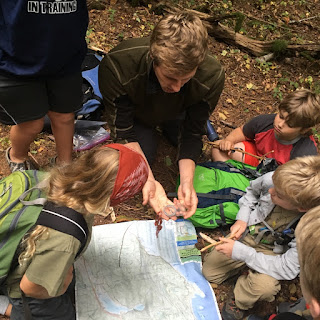Our Teddy Bear Traverse was a rich experience full of natural
history and exploration. Meeting at the North Chuckanut Trailhead the mentors
wanted to cover an important safety topic before we headed out on our traverse.
In order to complete our trek and make it to our pick-up location the group would
have to cross Chuckanut Drive three separate times. The mentors cautioned the
group to stay hyper vigilant and focused during these times.
Lined up and ready for our first crossing both North and
Southbound traffic stopped and an annoyed driver tried to pass one of the
stopped vehicles. The driver spotted our group across the road and immediately
came to a stop. Safely on the other side of the road the boys circled up for
our opening meeting and we debriefed what had just happened. It was a great
reminder of the number one rule of the wilderness: pay attention.
Looking at a map of the traverse the boys worked hard to
orient to the landscape and cardinal directions. Once jobs were divvied up the Tribal Elder facilitated the group’s
decision to head due south across the wetland, and we were off!
Crawling and climbing through a dense thicket of
Salmonberry, Vine Maple, and Devil’s Club the boys followed each other closely,
choosing the easiest lines of travel. Once the group had navigated the wetland
the Front Scout made a keen
observation. Looking at the retaining wall above us, he suggested that an
easier path of travel might be along the wall as there was graffiti it’s entire
length; which meant there must have been a footpath at its base. Jedidiah
explained to the boys that reading the landscape as the Scout had just done and the type of inference he was able to make
from his observations was a key component of tracking and navigation.
The group decided not to venture up towards the retaining
wall because of the significant erosion it would cause. The mentors went on to
explain that the first quarter mile of our traverse was in the Chuckanut Creek
watershed and there were salmon currently spawning. Any erosion we created
would significantly impact the salmon runs.
After another twenty minutes of travel through a lush valley
of Sword Ferns we arrived at Woodstock Farms and headed down to Mud Bay for
some lunch. Looking out across the bay the boys noticed a few clusters of shore
birds foraging in the tidelands. Jedidiah pulled out his binoculars and each of
the boys took a turn. It was a great day by any birders standards. We spotted
Surf Scoters, Goldeneye, Mergansers, Eagles, Heron, and Grebes. One of the boys
also noticed that the eroding shoreline seemed to be made up of entirely of clams
and oyster shells. Crawling under the overhanging bank the mentors explained to
the group that this was a pile of Shell Midden leftover from the Salish
peoples. Shell Midden piles can be found throughout the Salish Sea along with
all types of artifacts preserved by the calcium from the shellfish. The boys
were excited and wanted to dig through the pile but the mentors stopped the
group, explaining that it was our job to leave this piece of natural history
intact to it would be there for generations to come.
We left Mud Bay and weren’t more than five minutes up the
trail when one of the boys called everyone over to puzzle at a bone that he had
found. After some investigation the boys discovered that it was a salmon bone.
The mentors asked the group why a salmon bone would be so far from the bay.
Scanning the landscape the boys determined that it must have been a Bald Eagle
feasting on the Salmon from atop a tree. The mentors pointed out that the
salmon bones and carcass provide vital nutrients from the ocean to the forest,
which wouldn’t be present without their journey up stream.
Nearing our second Chuckanut Road crossing we started to
hear voices of what could only be the Girls Explorers Club. Sure enough we
crested the hillside and there were three groups of GEC girls working on a
service project. We chatted for a little while and the girls let us know that
there was an owl pellet ahead on the trail. Saying our goodbyes we rounded the
corner and took a close look at the owl pellet, which Jedidiah determined to be
Coyote scat with Cottontail bones and fur in it. One of the Explorers pointed
out that our traverse through the land was giving us a snapshot of the animals
that lived and migrated through this area.
Safely across Chuckanut Drive we made some ground along the
interurban trail only stopping to look at a Robin’s nest. Coming to our last
Chuckanut Road crossing the group was very patient as they waited for the
seemingly endless line of cars to pass by. Hiking down the steep switchbacks
the boys realized they had made it to Teddy Bear Cove.
Pulling out the remnants of their lunches the boys spread
out over the Sandstone bluff and soaked up the views. NOAA had forecasted heavy
rain for our outing, but miraculously the day had been dry with the occasional
sun break. Looking over the Olympic Mountains the sky was fiery orange and
yellow and we could see the almost sheet like rain coming down in buckets. It
was a great time for the boys to decompress and revel in their accomplishment.
The boys wanted to spend some time on the beach and navigated
to the North side of the cove where they spent quite awhile harvesting clay
from the embankment near the breakwater. This was the perfect container for the
mentors to sit back as the boys engaged in free play. Their play led to two
more natural history discoveries: River Otter poop and the mysterious
intertidal creature called a Hooded Nudibranch.
Calling the group together we played a few rounds of Otter Steals a Fish and circled up for
our closing meeting. The boys gave thanks for the fall season and for all the
mystery and wonder that lives in the landscape. This closing meeting would mark
the end of the first half of our 2016/17 season of traverses. Looking back we
recalled each our traverses and revisited the powers and challenges of our
experiences. Our mentors look forward to picking up where we left off in
mid-January. Parents, dates for the second half of the 2016/17 season will be
posted on the Black-tailed Deer group
page by December 5th. We
appreciate all your support and encouragement for the work we do. We hope you
have a wonder Holiday break!
For more photos from our outing please visit the BTD’s photo album from the day.


























